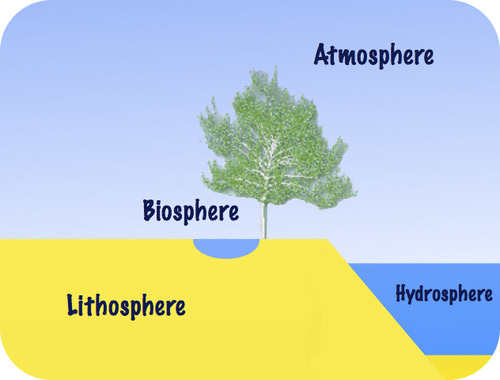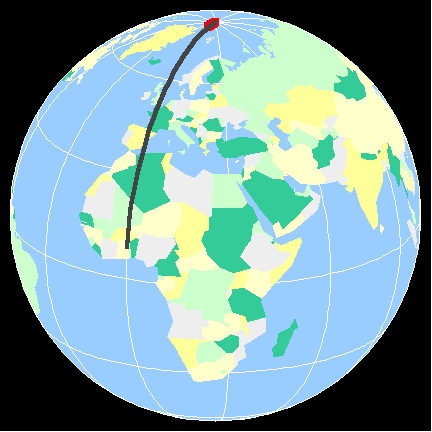How do you know what you know?
Seriously. How do you know something? What is something you are sure of and question yourself why you believe it.
I want you to think for yourselves. There is tons of information out there and lots of misinformation. You need to question things and let evidence drive your beliefs.
So, let's start with an easy one:
What is the shape of the Earth?
Prove it
While you are thinking about how to prove it, I'll have you know that humans have "known" the shape of the Earth for thousands of years. Over two thousand years ago, someone even calculated exactly how large a spheroid Earth is (with astonishing accuracy--we will recreate his experiment).
Is there any way to see the curve of the Earth? Maybe at sea or on the great plains. What about looking at Earth's shadow as cast on the moon?

Earth's shadow is always circular. No matter when or how or from where it is viewed, its shadow is always a circle.
Sailors noticed something. The first part of a ship visible was the mast always and the last part of the ship to disappear was also the mast (that is why they stuck a lookout up there). Why would that be? It appears as though the ship sinks into the sea as it sails away.
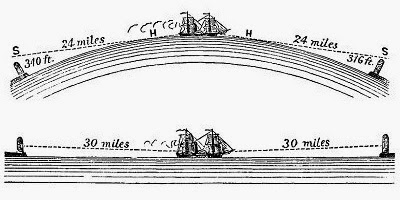
Ship's masts are the first to be seen and the last to disappear. Something that makes much more sense if the ship is on a curved surface.
Ignore the words and numbers on this image. I put it here to show you that when we look at every other planet (and the sun, moon, even large asteroids), they are all spheres. We can watch them spin and see all around them. Why would Earth be any different?
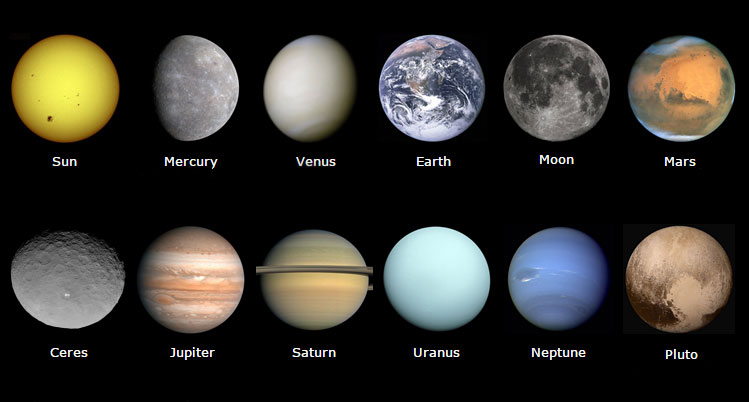
All other planets and moons are spherical.
You will note, that nothing we have seen so far requires much in the way of modern technology to see. That is why the ancients knew about the shape of the Earth.
Along came a brilliant man named Eratosthenes, who was a librarian and mathematician. He noted that people in Syene could see the bottom of their well at noon on the Equinox, while he in Alexandria could not. He used the difference in the shadow angles and the distance between the two cities to calculate the circumference of the Earth. This was about 200 BCE!

Then there was a man named Eratosthenes who noticed that different parts of Earth had different shadows at the same time...

This was that man. He not only knew that the world was spherical, but exactly how large the world was thanks to a simple ratio that we will use as well when we recreate his experiment.
So, for thousands of years, we have known the size and shape of the Earth. But if you are not convinced, here is more evidence:
We have traveled around the Earth completely without falling off...

We have seen it from outer space.
And if you really don't want to do all those experiments, you could trust that the scientists who study this stuff all agree on it. And, considering the importance of being skeptical and questioning to science, to get all of them to agree on something is really amazing.
With more precise measurements (we use lasers to do this nowadays), we get this:
An oblate spheroid - bulging at the equator and flatter at the poles.
How big is the Earth?
Let's do what Eratosthenes did to find out.
You will find the lab guide for recreating Eratosthenes's experiment here.
What is the earth made of?

The lithosphere is all the solids (i.e. rocks and minerals).
The hydrosphere is all the liquids (i.e. ocean and rivers).
The atmosphere is all the gases (i.e. air)
The biosphere is all the living things, but that will be the focus of life science, not Earth science.
Our last section will be astronomy where we can compare Earth with other celestial bodies.
The lithosphere:

There is a thin crust, a squishy asthenosphere, a thick mantle, a liquid outer core, and a solid inner core. How do you suppose we know about the inside of the Earth considering we have never dug beneath the crust? We will learn all about this later this year.
The hydrosphere:

This includes the reservoirs that hold water (oceans, glaciers, groundwater, surface water, etc.) and the processes that move water around (evaporation, condensation, precipitation, infiltration, etc.). We will learn about each of these units later this year.

Atmosphere:

As you can see, the atmosphere is mostly nitrogen. It has layers as well:

The image on the left is to show that pressure decreases as you climb in elevation.
The image on the right shows what marks the different layers of the atmosphere (increasing or decreasing temperature).
Why do you suppose the temperature changes like that? We will learn much more about that later this year.
What is this ball of rock, water, and nitrogen doing?
Does it sit there in space?

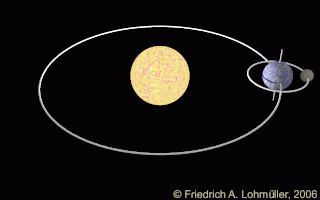
Rotation is spinning on our axis. It takes 24 hours to do it.
Revolution is traveling around the sun. It takes roughly 365.25 days to do it.
But how do we know?
You might argue that we know that the Earth rotates because of day and night. But that could be caused by the sun moving. However, everything in the sky moves across the sky at the same rate (15 degrees / hour). That seems a little coincidental. Then there is the coriolis effect:
This is called the Coriolus Effect and proves that the Earth is rotating.
Night and day can be explained away, but not the Coriolus Effect.
Coriolus Effect - the deflection of loosely held fluids on a spinning surface.
Ours deflects clockwise in the Northern hemisphere and counterclockwise in the Southern due to the direction of rotation.

One thing to note about this spinning is that we do not experience the sun the same all the world around. When the sun is up here, it is down elsewhere. When it is at its highest point here (noon), it is barely risen in California (9 am). See below:


Time zones are further proof of rotation. As is the movement of every object in space across the sky at the exact same rate (15 degrees per hour). The simplest explaination is that they are relatively stationary and we are spinning at that rate (360 degrees in 24 hours breaks down to 15 degrees / hour).
How can we prove that we are revolving around the sun?
Some may say the seasons prove that. And they might be right, but we could explain away the seasons (though it would be much harder to explain why the northern hemisphere and the southern hemisphere have opposite seasons).
Is there something that changes when you view things from different places? Try this: extend one arm. Stick your thumb up on that extended hand. Shut one eye. Now use the thumb to block out something in the distance. Got it. Now, switch eyes. What happened?
It appears that your thumb moved. But it didn't. Switch eyes back and forth and watch the apparent movement of a near object (your thumb) relative to a distant object. This is because the objects are being viewed from two different spots. It is called parallax.
What if near objects in space jump around like that relative to distant objects. Predictably leaping like your thumb did. They do! All because we are viewing those stars from different spots in space on our path around the sun.

Paralax explains the apparent movement of stars in space as viewed at different times of the year.
This paralax is the result of viewing from two different points, in other words the Earth must move around the sun in space.
Paralax - the apparent movement of near objects relative to distant objects due to the objects being viewed from two different locations.
This movement also causes the seasons:
See, the Earth is tilted on its axis of rotation (23.5 degrees). When the northern hemisphere is tilted towards the sun, the sun is more overhead, the rays are more direct, and the sun is up longer. This heats the north up and we call it our summer. When we are tilted away, the sun is lower on the horizon, the rays are glancing, and the sun is up for a shorter time. This cools the north off and we call it winter. Halfway in between, the sun is directly above the equator and everyone gets 12 hours of daylight and 12 hours of darkness. We call those days the equinoxes.

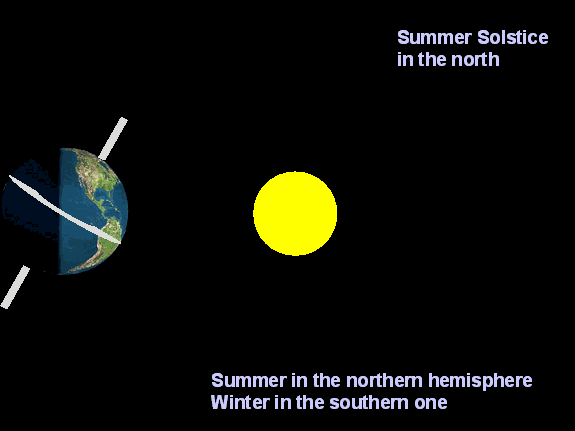

The seasons are caused by the uneven heating of the Earth as a result of our tilt as we revolve around the sun.
Make note of the solstices and equinoxes. Our tilt is 23 and a half degrees. That number shows up again and again (tropics of Cancer and Capricorn, Arctic and Antarctic circles).
Seasons could be explained away, but are further evidence of revolution.
So Earth is a big spheroid object made of rocks and water and air rotating and revolving in space, but why?
How did it get this way?
Let's look at how planets are formed to illuminate this:
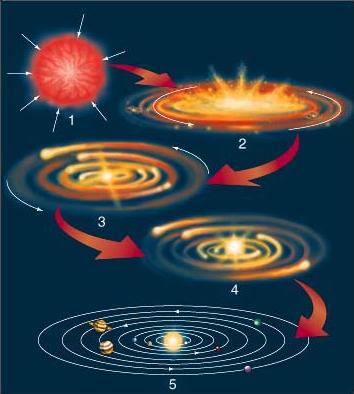
This is a short version of the formation of solar systems as we have seen formed elsewhere in the universe and assume ours formed the same way. Basically, there was a big bang sending everything flying away from a central point in the universe. Masses of gas and dust floating in space condense due to gravity. When enough gets together the attractive force of gravity fuses some of the atoms together. This releases tons of energy in the form of heat, light, and the rest of the electromagnetic spectrum (a sun is born). The masses that were not big enough to cause fusion become planets and moons and asteroids and comets (we will learn about all these later this year). The energy from the movement from the big bang makes everything swirl around like an eddy. All the planets revolve around the sun in the same direction (the same direction the sun rotates). And almost all the planets rotate in the same direction, but we will come back to this.
Once all that gas and dust settled into a spheroid, early earth would have looked something like this:
With no atmosphere to burn up meteoroids and so many flying around, we were riddled with craters.
But all that bumping of molecules generated a lot of heat and so beneath that calm, rocky surface, rocks were melting and getting hot.
As you know heat rises:
Volcanoes cropped up everywhere.

You will notice in there that there is water vapor. This condensed into clouds and rained down in thunderstorms that lasted thousands of years.
There was no ozone layer for absorbing harmful, mutating UV rays from the sun.
It was an energetic place.
But over time the Earth cooled off and the meteors died down (fewer particles left flying through space as well as an atmosphere to burn up in), organisms developed that produced oxygen and soon an ozone layer was present; things calmed down to where they are today, but it took a long time to get here.
How long, you ask?
Here is a quick glimpse:
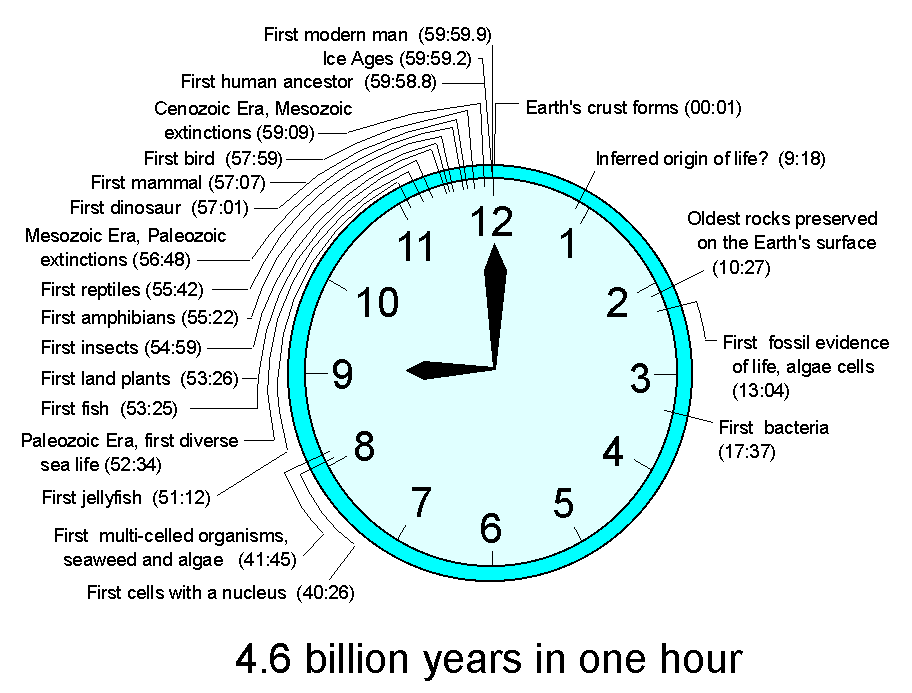
But how do we know, you ask. Great question...
